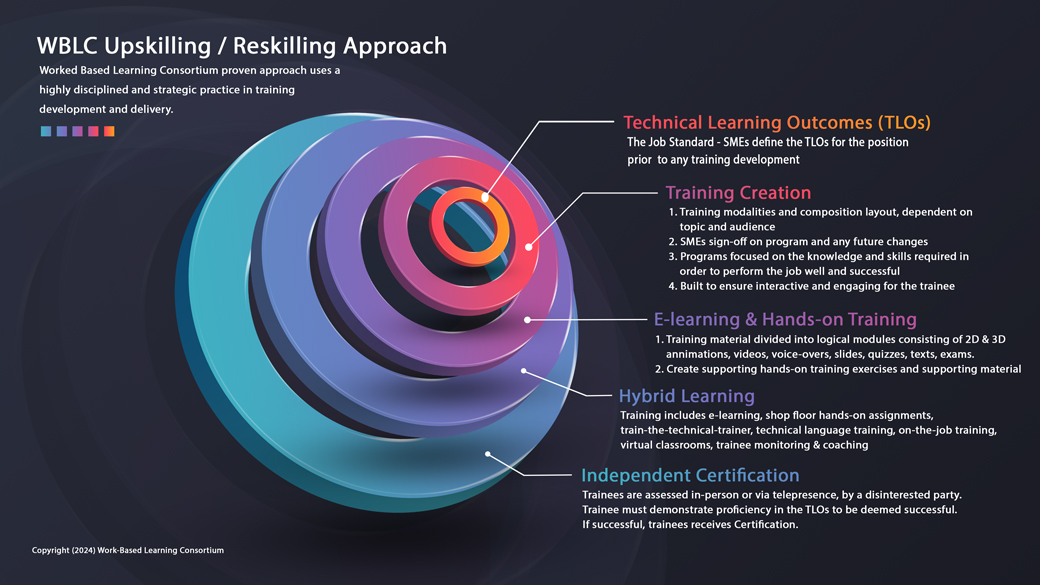How do you consistently develop highly effective training for disparate industries, particularly when the culture, employee base, and focus can be so different across industries?
Executives at Worked Based Learning Consortium (WBLC) point to a proven approach — embrace a highly disciplined and strategic practice in training development. WBLC has developed proven training programs across a of range of industries – CNC Machinist training for the manufacturing industry, entry level training for the wind turbine industry, and graphic installation technician training for the sign industry, to name a few.
“Many companies have always done on-the-job training but typically it is done in an informal, unstructured way,” explains Rod Jones, Managing Director of WBLC. “I call the process ‘osmosis’ – exposing trainees to educational content and hope enough of it sinks in to be successful.”
Organizations typically do not pre-determine exactly what trainees need to learn and trainees aren’t always measured at the conclusion of training – elements that WBLC views as important to highly effective training success.
WBLC’s Layered Approach to Training Development
“Identifying the job standard, meaning defining what the technical learning outcomes are for a given position, is a crucial first step before we even start developing the training content,” says Jones.
Technical learning outcomes are the skills and knowledge that a person is required to learn and demonstrate in order to be assessed successful in a given job.
“Technical learning outcomes also are a highly effective benchmark for measuring a trainee’s success,” adds Jones. “Have they successfully learned the competencies taught in the training?”
Getting Started – Subject Matter Expert (SME) Involvement is Critical
Who is better to identify the skills and knowledge required than a panel of subject matter experts (SME)? This is an essential first step.
During these scripted conversations, WBLC works very carefully with the subject matter experts to identify the necessary information, which are the backbones upon which WBLC’s training is developed.
“These sessions are invaluable, but they also follow a very detailed, methodical process,” says Reema Duggal, a lead for the virtual learning initiatives with WBLC. “People don’t generally talk at this level of detail. One of the keys to our success is the skill that our team has in working with these experts to extract all of the information that is needed.”
Once captured and the information is assembled, WBLC then designs and builds the course content, thinking about the best way to communicate the information.
Hybrid Upskilling Approach
WBLC has developed a hybrid approach to upskilling, which has e-Learning and on-the-job training at the core and layering in other elements to deliver a blended and comprehensive approach. WBLC’s learning programs typically include interactive e-learning, e-instructor led virtual classroom, train the technical trainer, on-the-job training, shop floor hands-on assignments to reinforce the e-learning, technical language training, monitor coaching and certification.
The employer is also a key participant by providing a technical trainer who conducts job instruction training and coaching for trainees, supported with practical exercises that reinforce the theorical e-Learning content that the trainees have just completed. Additionally, WBLC offers a train-the-trainer program to ensure a positive and robust experience for the trainees.
All About Achieving Results
WBLC has had strong success creating a range of upskilling programs. It received strong, positive feedback for both the recently developed graphic installation technician training program as well as the entry level program for the wind turbine industry. One of its longest running programs designed to develop CNC machinists continues to have expanded enrolment.
“We work very hard at creating high-end e-Learning,” adds Duggal. “Good e-Learning has always been welcome. We want people to learn and master skills at a specific level, regardless of what industry they’re in. That’s really what we’re after – a solid understanding of each topic and we’ve received very good feedback about our e-Learning programs along the way.”
A funder’s comment on WBLC’s unique approach
‘Frankly, we have never encountered another company, large, small or otherwise, that does as full and proper job of defining learning outcomes for a skilled job position at the outset as WBLC does.’

